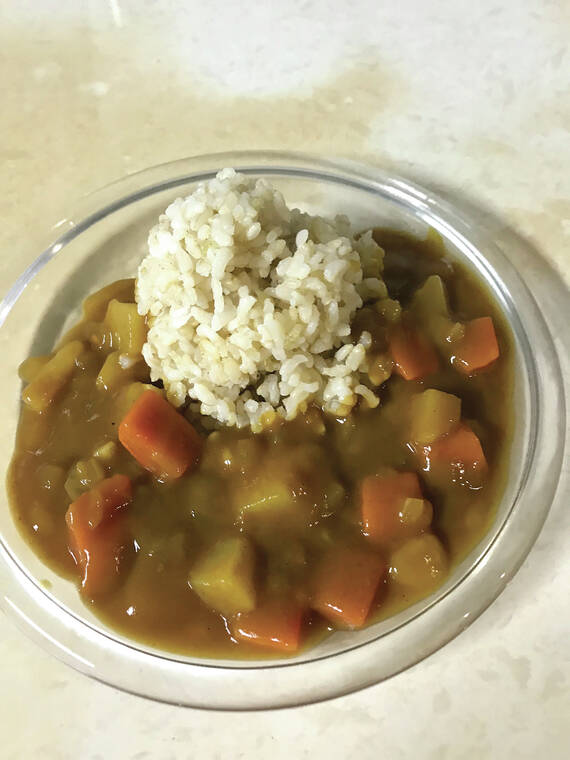Let’s Talk Food: Japanese curry

Photo courtesy Audrey Wilson Japanese Curry.
Curry was introduced to Japan during the Meiji era, between 1868-1912, when the Indian subcontinent was under British rule. The soldiers of Indian descent in Japan then introduced them to curry. This dish took off in popularity and the rest is history.
Curry was introduced to Japan during the Meiji era, between 1868-1912, when the Indian subcontinent was under British rule. The soldiers of Indian descent in Japan then introduced them to curry. This dish took off in popularity and the rest is history.
The word curry was adopted into their language as “kare” and became a staple in the Japanese diet, especially because it goes so well with rice, a staple in Japan.
ADVERTISING
In 1873, a dish called “kare raisu” or curry rice, was on the menu of the imperial Japanese Army Military Academy.
The recipe has been tweaked to adapt to the Japanese palette, and by 2000, it was more popular than sushi or tempura, thanks to the Japanese Navy, whose sailors ate a meat stew with curry seasoning and bread as a side dish for their many voyages. This dish was called “Kaigun Kare” or “Navy Curry.” Beef or chicken meat, potatoes, onions, carrots, rice and curry roux and a chutney of pickled vegetables or “tsukemono” was served.
Regions had their own special curries which includes:
• Hokkaido sika deer curry or “ezo shika kare” from Hokkaido.
• Scallop curry or “hotate kare” from Aomori Prefecture.
• Mackerel curry or “saba kare” from Chiba Prefecture.
• Apple curry or “ringo kare” from Nagano and Aomori Prefecture.
• Natto curry or “natto kare” from Mito and Ibaraki.
• Nagoya Kochin chicken curry or “Nagoya kochin chikin kare” from Aichi Prefecture.
• Matsusaka beef curry or “Matsusaka beef curry” from Mie Prefecture.
• Nashi pear curry or “nashi kare”for Shimane Prefecture.
• Oyster curry or “kaki kare” from HIroshima Prefecture.
• Black pork curry or “kurobuta kare” from Kagoshima Prefecture.
• Bitter melon curry or “goya kare” from Okinawa.
There are three levels of heat in Japanese curries:
• Amakuchi or sweet, mild and mild enough for children.
• Chuukara is a little spicy but still easy to eat. If amakuchi was rated 1-2 in heat, chuukara is level 3.
• Karakuchi is hot and spicy curry which would be level 4-5 or 6 in heat.
Curry roux is a combination of cooked flour and fat, which is how the curry becomes thick. It is similar to French roux but French roux usually uses butter for a thick, creamy sauce.
My favorite Japanese curry recipe calls for grated apples which make it more similar to the Vermont Curry. I like a simple Japanese curry with just a few items, like just carrots and also as a sauce with tonkatsu or chicken katsu.
Japanese Curry
Cook together until onions are translucent:
1 onion, minced
2-1/2 teaspoons vegetable oil
Add:
3 tablespoons plus 1/2 teaspoon all purpose or gluten-free flour
If the flour sticks to the bottom of the pan, simply stir in and lower the heat. This is good as it is helps to build flavors and is called fond.
Mix to blend, add:
5-2/3 cups chicken or vegetable stock
1 medium peeled grated apple
2-1/2 teaspoons grated fresh ginger
2-1/2 teaspoons garlic, mashed
1-1/4 teaspoons garam masala (recipe follows)
2-1/2 teaspoon mild yellow curry powder (recipe follows)
2 tablespoons brown sugar
1 tablespoon soy sauce
When thickened, add whatever vegetables you have, carrots, pumpkin, or serve alongside chicken katsu with hot rice.
• • •
Homemade Garam Masala Spice
Mix together and store in an airtight glass container:
1 tablespoon cumin
2 teaspoons coriander
2 teaspoons cardamom
1-1/2 teaspoons ground cinnamon
1 teaspoon black pepper
1/2 teaspoon freshly ground nutmeg
1/2 teaspoon ground cloves
1/2 teaspoon cayenne pepper
• • •
Homemade Mild Curry Powder
Makes 1/3 cup
2 tablespoons coriander seeds
1-1/2 tablespoons cumin seeds
1 tablespoon yellow mustard seeds
1-1/2 tablespoons black peppercorns
1-1/2 tablespoons ground turmeric
1 teaspoon ground ginger
1/4 teaspoon ground cinnamon
Grind all in a spice grinder until finely ground, about 30 seconds.
My son Dean, who owns White Guava Cafe, has great memories of eating at Curry House CoCo Ichibanya while going to Kapiolani Community College. The curries were inexpensive and delicious.
Maybe Dean will be motivated to make Japanese curry for a special of the day one day.
Foodie bites
Ichibanya began as a cafe in 1974 in a Nagoya suburb. Tokuji and Naomi Munetsugu then launched a curry restaurant because Naomi’s curry dish was so popular. Curry House CoCo Ichibanya opened in 1978 in Nishi-Biwajima, Aichi Prefecture. In the 1990’s the couple expanded their business into a franchise under a unique program to help employees set up their own business.
Under the Bloom system the couple developed, Ichibanya employees spent at least two years learning about the business before they were allowed to become independent operators of a CoCo Ichibanya outlet.
In 2002 House Foods became the second largest shareholder, with a stake of 20% of the business and will be spending 246 million to own a majority stake in Ichibanya. House Foods is the maker of Vermont Curry so the partnership fit perfectly together and has expanded throughout Asia and the U.S..
Hawaii Community College’s Culinary Program Cafeteria and Short Order menu in the Cafeteria will be open from tomorrow until Thursday. Please call between 9 a.m. and 1 p.m. to place your orders. Wednesday specials are Plantation Beef Stew for $9.95 and Pork Guisantes for $9.95. Specials for Thursday include Korean chicken fro $9.95, Eggplant Parmesan for $9.95 and Striploin Steak, 8 ounces for $12.95. Please support the culinary students.
Email Audrey Wilson at audreywilson808@gmail.com.


